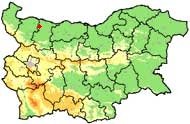Area of Zlatiata - biggest compact unpopulated lowland area in Bulgaria
Article published from bspb.org on 2007-10-10 12:00:00Category: Travel in Hayredin
Zlatiata is located in north-western Bulgaria, in the Danubian Plain, between the Danube river and the town of Kozloduy to the north, the road connecting the towns of Vulchedrum and Hayredin to the south and the courses of the rivers Tsibritsa and Ogosta to the west and east. It covers a plateau with open grasslands of steppe character and arable lands. At certain places there are earth loess walls and low trees and shrubs, composed mainly of Crataegus monogyna, Rosa canina, etc. Ailantis altissima is abundant on the earth walls and around them. The territory of Zlatiata includes the water reservoir Shishmanov Val. There are also dispersed pastures, orchards, vineyards, wind protection belts, small broadleaved woodlands and riverine forest along Ogosta River.
The area supports 122 bird species, 28 of which are listed in the Red Data Book for Bulgaria. Fifty-six species are of European conservation concern (SPEC) (BirdLife International, 2004). Five species are included in category SPEC 1 as globally threatened, 15 in category SPEC 2 and 36 in category SPEC 3 as threatened in Europe. Zlatiata is one of the most important sites in the country on European Union scale for a complex of species dependent on open habitats - the White Stork Ciconia ciconia, Marsh Harrier Circus aeruginosus, Montagu`s Harrier Circus pygargus, Levant Sparrowhawk Accipiter brevipes, Red-footed Falcon Falco vespertinus, Tawny Pipit Anthus campestris, Greater Short-toed Lark Calandrella brachydactyla, Ortolan Bunting Emberiza hortulana, etc. It holds significant breeding populations of the European Bee-eater Merops apiaster, Skylark Alauda arvensis and Common Quail Coturnix coturnix. The area is the only place in Bulgaria, where the Great Bustard Otis tarda has been recorded recently. During the winter other globally threatened bird species occur in the area – the Lesser White-fronted Goose Anser erythropus. The species use the arable land to feed there together with flocks of the White-fronted Goose Anser albifrons.
Zlatiata is the biggest compact unpopulated lowland area in the country. It is sensitive to the human activities related mainly to agriculture, forestry and infrastructure. Intensification of the agriculture, use of pesticides and fertilizers, removal of hedges and bushes have the most serious impact on the quality of habitats. Cutting of the riverine forests, as well as trees of the wind prevention belts cause rapid decline of population of Red-footed Falcon, because of disappearance of suitable nesting sites. Hunting and poisoning have significant impact on the bird populations. One potential threat both to the habitats and to the birds in the area is the development of wind turbine farms.



